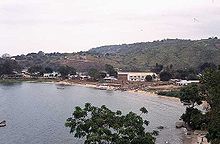Cynotilapia afra
| Cynotilapia afra | ||||||||||||
|---|---|---|---|---|---|---|---|---|---|---|---|---|

Cynotilapia afra |
||||||||||||
| Systematics | ||||||||||||
|
||||||||||||
| Scientific name | ||||||||||||
| Cynotilapia afra | ||||||||||||
| ( Günther , 1894) |
Cynotilapia afra ( Syn .: Hemichromis afer , Paratilapia afra ) is aso-called mbuna that lives endemically in Lake Malawi and thus belongs to the family of African cichlids . The species is native to the central and northern parts of Lake Malawi. However, the location variants differ very strongly, so that it is common to give the animals a nickname in order to take their different coloring into account. The nickname is either a nearby location on Lake Malawi or a coastal or island region where the animals were first found. Due to the many variations, it can be seen that the animals are very true to their location. Cynotilapia afra feed mainly on growth and microorganisms living in them.
habitat
Cynotilapia afra inhabits the upper rock littoral with its partly very steep bank zones. These are scree zones in which the rocks form caves and niches and only change into sandy soil from greater water depths of more than 15 meters. These rocks are overgrown with algae that are used by the animals as food. There it forms large groups in which the males occupy territories of about one square meter. The semi- adult animals do not live separated by sex above the Felslitorals.
Systematics
Cynotilapia afra is easy to confuse with the genus Pseudotropheus , since both have almost the same body drawing. This includes the body shape and the body stripes. The difference lies in the dentition, in which Cynotilapia shows a further apart, single-pointed dentition, whereas Pseudotropheus species has double-pointed and narrower dentition. The coloring of the black pigments in the body stripes, as well as the striking different colors of the dorsal fins, are typical features of Cynotilapia afra . The males are consistently larger (about 7 cm) than the females (about 5 cm) with a light blue body color and dark blue horizontal stripes in the male and the beige-brown to light blue colored females. The species is considered to be omnivorous .
Reproduction
Cynotilapia afra is a maternal , ovophilic mouthbrooder , in which the female incubates the brood in the mouth. Pairing is limited to the process of spawning. Then the sexes separate again. During the breeding process, the territories are aggressively defended by the males. The species is not very productive, around 20–30 juveniles, which is not uncommon for mouthbrooders. After about 21 days, the female releases fully developed fry. During the breeding season the female stops feeding. Male Cynotilapia are polygamous and keep a harem of several females.
variants
Known Cynotilapia afra - morphs with their occurrence in the lake are:
- Cynotilapia afra (Chewere)
- Cynotilapia afra (Chiloelo)
- Cynotilapia afra (Chinuni)
- Cynotilapia afra (Chitande)
- Cynotilapia afra (Chuanga)
- Cynotilapia afra (Cobue)
- Cynotilapia afra (Jalo Reef)
- Cynotilapia afra ( Likoma )
- Cynotilapia afra (Lumbila)
- Cynotilapia afra (Lundu)
- Cynotilapia afra (Lupingu)
- Cynotilapia afra (Mbenji)
- Cynotilapia afra (Mbweca)
- Cynotilapia afra (Metangula)
- Cynotilapia afra (Minos Reef)
- Cynotilapia afra (Msobo)
- Cynotilapia afra (Ndumbi)
- Cynotilapia afra (Njambe)
- Cynotilapia afra ( Nkhata Bay )
- Cynotilapia afra (Nkolongwe)
- Cynotilapia afra (Nkhungu Reef)
- Cynotilapia afra (Ntekete)
- Cynotilapia afra "Hai Reef" (Puulu)
- Cynotilapia afra "Thumbi Point" (Thumbi)
- Cynotilapia afra "Tumbi Point" (Thumbi)
- Cynotilapia afra (Undu Reef)
Cynotilapia species for which a precise assignment is still missing:
- Cynotilapia sp. "Black Dorsal"
- Cynotilapia sp. "Black Eastern"
- Cynotilapia sp. "Blue and Blue"
- Cynotilapia sp. "Chinyankwazi"
- Cynotilapia sp. "Lion" (Lion's Cove)
- Cynotilapia sp. "Lion" (Magunga)
- Cynotilapia sp. "Maleri" (Nakantenga)
- Cynotilapia sp. "Mbamba" (Lion's Cove)
- Cynotilapia sp. "Mbamba" (Nkhata Bay)
- Cynotilapia sp. "Ndumbi"
development
While it usually takes many thousands of years to develop a new species, the circumstances are completely different for the species found in Lake Malawi. According to studies, over 1000 species of fish have developed here in just 500,000 years. This frenzied evolution is a mystery in and of itself, but the Southeast African Malawi inhabitants of the species Cynotilapia afra are to be regarded as real exceptions. Within just 20 years, two genetically completely different species have evolved in this species. The American biologist Todd Streelman demonstrated that an accidentally released Cynotilapia afra population on the island of Thumbi (West), near Mitande, in 1960 , which had not moved there since 1983, was still there when it visited again in 2001 but had evolved into two completely different types. One species lives south of the island, the other north of it. Since the color patterns play a decisive role in choosing a partner, especially at Mbunas, there are significant differences in the color dress of both species.
literature
- Rüdiger Riehl , Hans A. Baensch : Aquariums Atlas . 2nd volume. Mergus Verlag., Melle 1997, ISBN 3-88244-011-2 .
- Ad Konings, Malawi cichlids in their natural habitat . 3. Edition. Dähne Verlag., Ettlingen 2001, ISBN 3-935175-00-0 .
- Herbert R. Axelrod, Warren E. Burgess, Neal Pronek, Jerry G. Walls: Dr. Axelrod's Atlas of Freshwater Aquarium Fish . Bede Verlag., Ruhmannsfelden 2001, ISBN 3-9801265-4-4 .
- Erwin Schraml: African Cichlids I Malawi: Mbuna species and variants . Aqualog Verlag., 1998, ISBN 3-931702-79-0 .
- Erwin Schraml: Coral fish of fresh water . Aqualog Verlag., 1998 ISBN 3-931702-48-0 .
Individual evidence
- ↑ Science Daily.com Study Suggests Humans Can Speed Evolution
Web links
- Cynotilapia afra on Fishbase.org (English)
- Image on malawicichlids.com
- Cynotilapia afra inthe IUCN 2013 Red List of Threatened Species . Posted by: Kazembe, J. & Makocho, P., 2006. Retrieved February 9, 2014.



